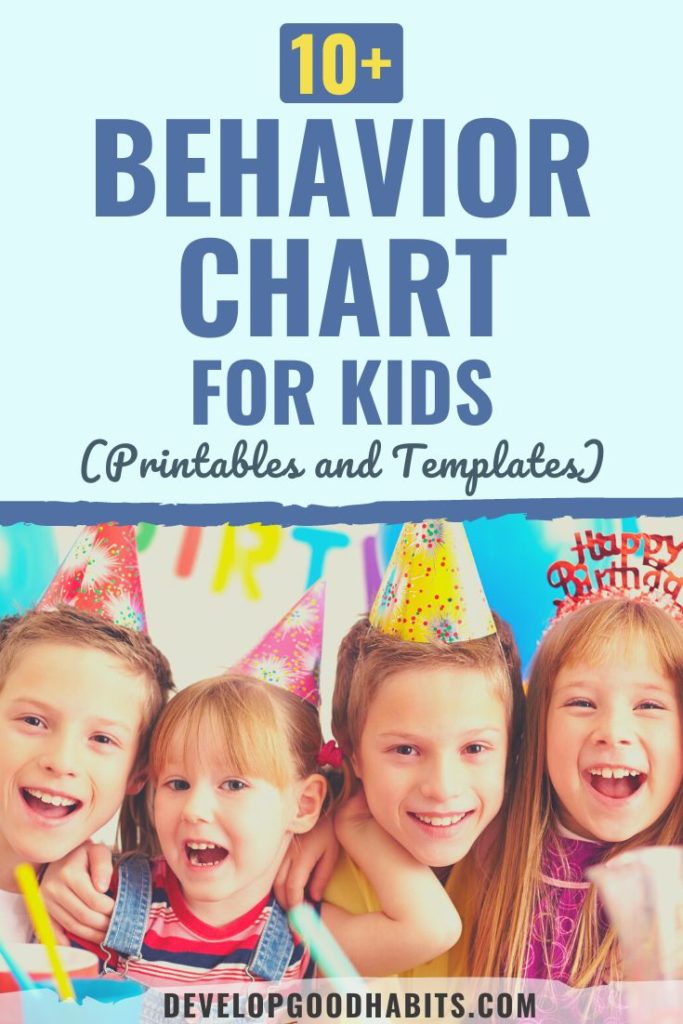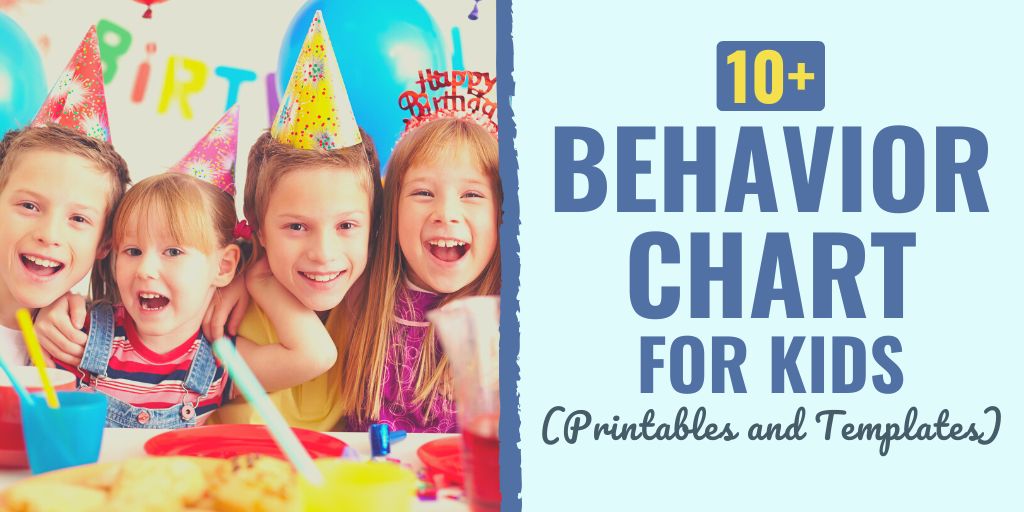There might be affiliate links on this page, which means we get a small commission of anything you buy. As an Amazon Associate we earn from qualifying purchases. Please do your own research before making any online purchase.
Behavior charts are a positive tracking system to help children reach their goals.
It is a good idea to encourage children to develop good behaviors, and charts can be an effective visual reminder of what they are working on.
There are different types of behavior and reward charts designed for children’s use. In this article, we’re sharing a collection of 12 behavior charts you can use for tracking your children’s good behavior.
When used effectively, behavior charts empower children to change undesirable behaviors into ideal ones, encourages them to continue exhibiting a desirable behavior, and helps them understand the value of effective goal-setting.
This collection contains ready-to-use printables and examples from which you can draw inspiration for your kids’ own behavior charts.
Before we get to the collection, here are some quick tips for using a behavior chart for kids effectively.
How to Use a Behavior Chart Effectively
Here’s a quick process for getting great results with a behavior chart:
- Decide on the specific behavior that you want your child to develop.
- Choose a chart design. To motivate your kids, you may want to choose a design that incorporates things that they love or are interested in.
- Introduce the key components of the chart to your children. Explain how the chart works to track their good behavior.
- If using a reward system, discuss the ultimate reward that your children can earn after meeting their goals.
- Be patient and gentle, especially when children are not (yet) meeting their targets.
Read on to check out our list.
1. Morning Checklist
Teaching children to have a morning routine helps them to embrace good habits when they’re older.
This customizable chart is a checklist activities that children need for a good morning routine. They can easily tick the boxes once they’ve accomplished the activities listed.
You might want to print out the chart and laminate it for reusability with a dry-erase marker.
2. Checkmark Chart
Older kids can benefit from a visual reminder to develop good behavior. A chart such as the one above might work well for children who are no longer interested in cartoon characters.
Instead of a graphic-rich chart, this example features checkboxes for every day of the week.
A column is provided where users can list behavior targets they need to work on. They can then track how well they’ve accomplished their target goals by putting checkmarks in the corresponding boxes.
3. Behavior Report
This chart was designed for classroom use, but can be modified for use at home or in a homeschool setting.
The user indicates how often he or she has displayed good behavior throughout the day, and a column displays the specific good behaviors being targeted.
There is also space at the bottom of the page for writing down notes. You can use this for summarizing or providing an anecdote about the student/child’s behavior throughout the day.
4. Dry Erase Board Chart Template
This very simple behavioral chart uses a dry-erase board and some colored Post-Its to keep track of desired behaviors and assign chores for older kids.
Parents can simply assign specific colored Post-Its to each child. Chores and target behaviors can then be written down for the specific child and placed on the board.
Once the child accomplishes the task, he or she gives the sticky note to the grownup for appropriate record-keeping.
In addition to encouraging good behavior, this type of chart also helps instill personal responsibility in older children, since they do not get verbal reminders from grownups about what they are supposed to do.
5. Summer Rules Checklist Template
For kids, summer vacation means freedom not just from schoolwork, but also from most of their responsibilities at home. Unfortunately, that means that they are often glued to their gadgets throughout the day during school breaks.
This worksheet ensures that a semblance of order remains during the kids’ vacation time. By giving your kids a set of tasks they need to finish before they can use their gadgets, not only are they being taught the value of having a routine, but they also spend less time on devices.
6. Set of Behavior Trackers
This set of behavior charts and trackers features techniques that encourage kids to behave well, including the ABC Chart and the Scatterplot Graph. Both of these charts promote mindful parenting.
ABC stands for:
A – Antecedent
B – Behavior
C – Consequence
When using this chart to track your child’s behavior, you are encouraged to reflect on what happens before an incident involving unacceptable behavior occurs (Antecedent), describe what the kid does (Behavior), and state the results or effects of the behavior (Consequence).
By doing this, you gain a better understanding of the root cause of the child’s behavior and are therefore in a better position to create intervention measures to prevent the behavior from recurring.
Meanwhile, the Scatterplot Graph is ideal for pinpointing the exact moment unacceptable behavior occurs. With this graph, you record the number of occurrences of a specific behavior in half-hour intervals. This way, you get a clearer picture of the times when a certain behavior occurs and create a way to prevent it from occurring or lessen its impact on both you and your child.
7. Rainbow-Themed Behavior Chart
This straightforward behavior chart provides a colorful visual representation of the goals you want your kids to achieve. The template is useful for encouraging good behavior throughout the week.
Each kid you’re monitoring for good behavior can have a clothespin marker that you can put on a printed sheet of this template. Their respective clothespins go up or down on the chart, depending on their behavior.
You might also use a reward system. For instance, kids whose clothespins are on the “Extraordinary” spot by the end of the week might get a reward that all of you have agreed upon earlier.
Hopefully, the kids who don’t make it that week will be motivated to do better next time.
8. World’s Simplest Behavior Chart
Here’s a simple system you can adopt for your household. The standout feature of this template is that the focus is on good behavior.
This chart is used for one week’s worth of monitoring. Each time a child exhibits good behavior, they get a point.
Hopefully, by the end of the week, they will be at 10. It’s up to you if you want to establish a reward system to go with this good-behavior tracker.
9. Behavior Punch Cards
These good behavior cards can be used to motivate kids to do more than just veg out on their devices.
You and your kids can discuss the rules of using the punch card system to instill good behavior. For example, you might establish a reward they can claim for having their cards punched.
10. Color Coded Behavior Chart
This chart is easy to make and very simple to use. It is a great system for tracking children’s behavior throughout the day.
The daily goal is to achieve “Red” status, which equates to “outstanding.”
The clothespin goes up or down along the edge of the chart, depending on how a child is behaving.
Landing on the purple part of the chart means that the grownup decides on a consequence for less-than-ideal behavior.
Some parents use wooden clothespins, with the child’s name written on it, as the indicator. This chart can be used to keep track of multiple children at one time.
11. Unicorn Behavior Chart
This chart features a unicorn design. You can also find other fun designs that kids will love on the creator’s website.
For this chart, children and grownups first need to discuss and agree upon a couple of things:
12. Good Behavior Chart
This chart has the following features:
Final Thoughts
Children are usually willing to improve their behavior when they are sufficiently engaged and empowered.
This can be a springboard for them to adopt good, healthy habits when they are older.
Visual reminders, such as these examples of behavior chart for kids, are a good way of capturing their attention and encouraging them to do well.
We hope you’ve found a favorite among the charts featured today.
For more resources about helping kids develop good habits, the following posts are worth checking out:
Finally, if you want to level up your parenting skills, then check out this resource that will show you how to get your kids to listen WITHOUT yelling, nagging, or losing control.


